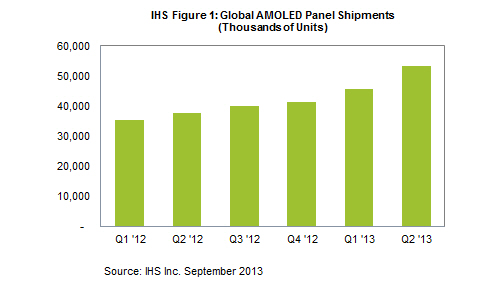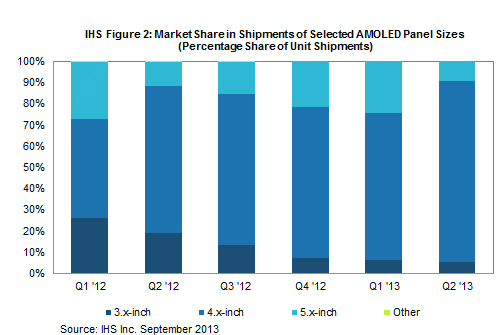As Samsung continues its ongoing onslaught of delivering just about every conceivable mobile device form factor on the planet - and everything in between as well, including its new curved display Galaxy Round - the company also continues to benefit from a good level of demand for its products, especially for its Galaxy S4. This demand has proven non-trivial if global shipments of high-end active-matrix organic light-emitting diode (AMOLED) display panels are any measure of success. And in fact they are.
According to the latest "OLED Displays Market Tracker - Q3 2013" report from IHS, global AMOLED display shipments during the period from April through June 2013 posted impressive sequential growth of 16 percent for the second quarter of the year. These shipments added up to 53.1 million units, a hefty increase compared to the 45.6 million units shipped in Q1 2013. Of even greater significance, and even more impressive, global shipments were up a huge 41 percent from the 37.6 million units in Q2 2012. Refer to the chart below for a graphical view of this impressive growth pattern.

(Click to enlarge)
IHS notes that the Samsung Galaxy S4 smartphone was the single largest parts-user of AMOLEDs in Q2 2013, with shipments of the 4.99-inch panels used in the S4 delivering 10 million units per month. This impressive number also fully underscores that the S4 is also the single largest growth driver overall for the AMOLED market. It translates directly into booming demand for the smartphone.
That said, the older Samsung Galaxy S III also continues to rack up big numbers for the 4.8-inch panel it uses. As one would expect however, total shipments for this panel size are now beginning to decline as the S4 also takes over as more and more users of the S III upgrade.
Samsung also employed a 5.5-inch AMOLED panel in the Note 2. It is worth noting that the Note 3 has just shipped and the new device - which of course is not reflected in Q2 2013 numbers will no doubt also continue to add to the total growth of the market. This all means - in a sense - that Samsung simply continues to pay itself rather than other vendors. Why?
Vinita Jakhanwal, director for Mobile and Emerging Display Technologies at IHS, says, “Samsung is clearly driving the rapid growth of the small-sized AMOLED market, with the company responsible for most of the supply and the demand for the panels. In terms of demand, the company’s smartphone business is the largest AMOLED panel consumer. On the supply side, Samsung Display is the largest AMOLED producer. With Samsung’s line of Galaxy smartphone enjoying fast sales growth, its AMOLED business is expanding quickly as well.”
Jerry Kang, senior analyst at HIS, adds, “Smartphones are the primary users of AMOLED panels, because of the displays’ image clarity, lighter weight and high contrast ratio over competitive panel technologies like low-temperature polysilicon (LTPS). Smartphones in the third quarter are estimated to have maintained their dominant share of the AMOLED market, with close to a 97 percent share. The remaining 3 percent is split among a passel of applications, including handheld gaming devices, digital still cameras, camcorders and tablets. In any case, however you look at it, Samsung leads the way."
Total Market Size
As shown in the chart below, among the various AMOLED panel sizes available, 45.2 million units - 85 percent of the total AMOLED panels shipped - were of the 4.x" category in Q2 2013. Roughly 5.0 million AMOLED units, or just about 9 percent of total shipments, was driven by the 5.x" segment. The last remaining sector of any real consequence was the 3.x" segment, with 2.8 million units or 5.3 percent shipped.

(Click to enlarge)
The remaining 1 percent represented panels in the 2.x- and 7.x-inch sizes as well as bigger panels used in televisions. These included panels in the 50-inch range, such as those used in Samsung’s new 55-inch OLED TV, launched in June to compete with a similar OLED model introduced by Samsung archrival LG Electronics.
Average Panel Size Selling Prices Are Up
It is well worth noting that the average size of panels sold in Q2 2013 amounted to 4.83 inches, or 0.6 percent more than 4.80 inches delivered in Q1 2013. Meanwhile, unit area prices (ASP (Average Selling Price)/inch), rose to $2.79, up 5 percent from $2.66 in the first quarter. The increase in average panel sizes resulted from the sharp growth in 4.99-inch panel shipments. The upgraded performance of AMOLED panels in this size, which employ full high-definition resolutions, appears to have boosted the ASP of the 4.99-inch panel, compared to the 4.8-inch.
While the AMOLED panel delivers show significant growth, by no means do they rule the overall display panel market. AMOLED displays only make up but a mere fraction of the overall market for display panels. Total shipments for small- and medium-sized panels in all applications for Q2 2013 amounted to 743 million units, still largely made up of liquid-crystal displays (LCD). OLED accounted for just 6 percent of the overall small and medium display market, and represented only 9 percent of the total mobile handset display business.
For Samsung that doesn't much matter - it clearly leads the way in AMOLED shipments.
Edited by
Alisen Downey  QUICK LINKS
QUICK LINKS